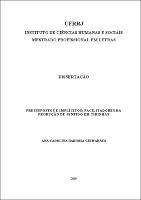Please use this identifier to cite or link to this item:
https://rima.ufrrj.br/jspui/handle/20.500.14407/15386| Tipo do documento: | Dissertação |
| Title: | Pressupostos e implícitos: facilitadores da produção de sentido em tirinhas |
| Other Titles: | Pressuppositions and implied information: enablers of the making of meaning in comic strips |
| Authors: | Guimarães, Ana Carolina Barbosa |
| Orientador(a): | Rodrigues, Gerson |
| Primeiro membro da banca: | Rodrigues, Gerson |
| Segundo membro da banca: | Pinto, Maria Isaura Rodrigues |
| Terceiro membro da banca: | Silva, Simone Batista da |
| Keywords: | Tiras cômicas;Pressupostos;Implícitos;Linguística Textual;Comic strips;Presupposition;Implied information;Textual Linguistics |
| Área(s) do CNPq: | Letras |
| Idioma: | por |
| Issue Date: | 18-Apr-2019 |
| Publisher: | Universidade Federal Rural do Rio de Janeiro |
| Sigla da instituição: | UFRRJ |
| Departamento: | Instituto de Ciências Humanas e Sociais |
| Programa: | Programa de Pós-Graduação em Letras |
| Citation: | GUIMARÃES, Ana Carolina Barbosa. Pressupostos e implícitos: facilitadores da produção de sentido em tirinhas. 2019. 130 f. Dissertação (Mestrado Profissional em Letras) - Instituto de Ciências Humanas e Sociais, Universidade Federal Rural do Rio de Janeiro, Seropédica, RJ, 2019. |
| Abstract: | A presente pesquisa tem como objetivo verificar se o reconhecimento de elementos subentendidos auxilia o aluno dos anos finais do ensino fundamental a produzir sentido ao ler tiras cômicas. Trata-se de uma pesquisa-ação que investiga como o aluno lê textos multimodais do gênero tira e como o professor pode aprimorar seu trabalho de mediador da relação leitor-texto-autor. A pesquisa engloba alunos do sexto ano do ensino fundamental de uma escola pública do município do Rio de Janeiro, ano escolar cujo currículo a nível nacional e a nível municipal não prevê o ensino das noções de informações subentendidas. Lidar com pressupostos e implícitos fica a cargo apenas do ensino médio, e tentamos, por meio deste trabalho, mostrar que não há uma série escolar mais ou menos adequada para se ensinar essa ou aquela noção. O corpus utilizado é composto por tiras cômicas de “Hagar, o Horrível”, criadas primeiramente por Dik Browne e, hoje, feitas por seu filho, Chris Browne. Este estudo está fundamentado nas teorias da Linguística Textual (KOCH, 1997; 1997; 2007; KOCH; ELIAS, 2015) e nos conceitos de tiras formulados por Ramos (2010; 2012; 2017) e Carvalho (2006). Assim, nesta pesquisa, sugerimos um roteiro de atividades interpretativas para que o aluno identifique não só pressupostos e elementos que os pressupõem, mas também informações implícitas e a tentativa de explicitá-las. Os alunos responderam a questões discursivas sobre tiras do personagem já citado em dois momentos distintos: antes e depois do contato com o conceito de pressupostos e implícitos (FIORIN; SAVIOLI, 2003). Para analisar a produção de sentido dos alunos, utilizamos tanto a abordagem qualitativa, com a elaboração de tabelas e gráficos daqueles dois momentos, a fim de compararmos as respostas que os alunos deram antes e depois. Como resultado, a análise das respostas dos alunos e dos números apresentados pelos gráficos e tabelas nos revela que identificar pressupostos e implícitos funciona como estratégia de leitura eficaz na produção de sentido de tiras cômicas; contudo, muito ainda precisa ser feito para melhorar as aulas de compreensão de texto, seja ele multimodal ou não. |
| Abstract: | The current research aims at verifying whether the recognition of presupposed and implied elements helps the student of the final years of elementary school produce meaning when reading comic strips. It is a research-action that investigates how the student reads multimodal texts of the genre comic strip and how the teacher can improve his or her work as a mediator of the reader-text-author relation. This research involves students of the sixth year of the elementary school from a public institution in the city of Rio de Janeiro, school year whose contents on a national and a city level do not suggest teaching implied information as a notion. Dealing with presuppositions and implied information is due to high school years, and we tried, through this work, to show that there is not a school year that would be more or less adequate for the teaching of this or that notion. The corpus used is composed by comic strips from “Hagar, the Horrible”, first created by Dik Browne, and, today, made by his son, Chris Browne. This study is based on the theories of Textual Linguistics (KOCH, 1997; 1997; 2007; KOCH; ELIAS, 2015) and in the concepts of comic strips formulated by Ramos (2010; 2012; 2017) and Carvalho (2006). Therefore, in this research, we suggest a script of activities of text interpretation so the student can identify not only presuppositions and elements that presuppose them, as well implied information and the attempt of make them explicit. The students answered discursive questions about comic strips of the mentioned character in two different moments: before and after getting in contact with the concepts of presuppositions and implied information (FIORIN; SAVIOLI, 2003). To analyze the meaning production of the students, we used quantitative and qualitative approaches, elaborating tables and graphics of those two moments, so that we could compare the answers given before and after. As a result, the analysis of students‟ answers, the tables, and graphics reveals that identifying presuppositions and implied information works as an efficient reading strategy in the meaning production of comic strips. However, there is much more to be done to improve the quality of reading comprehension classes, whether the text is multimodal or not. |
| URI: | https://rima.ufrrj.br/jspui/handle/20.500.14407/15386 |
| Appears in Collections: | Mestrado Profissional em Letras |
Se for cadastrado no RIMA, poderá receber informações por email.
Se ainda não tem uma conta, cadastre-se aqui!
Files in This Item:
| File | Description | Size | Format | |
|---|---|---|---|---|
| 2019 - Ana Carolina Barbosa Guimarães.pdf | 3.18 MB | Adobe PDF |  View/Open |
Items in DSpace are protected by copyright, with all rights reserved, unless otherwise indicated.

